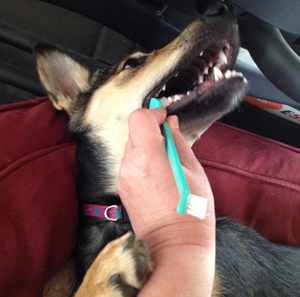

Jackson remains unconvinced that he should allow his
teeth to be brushed. Photo by Dr. Teri Ann Oursler
For all of the years that I practiced veterinary medicine, I recommended to clients that they brush their dogs’ and cats’ teeth to prevent tooth decay and loss of teeth. However, I never managed to employ this regimen in my own home. It is a classic case of the cobbler’s children having no shoes!
What has me thinking about this now? Jackson is the first dog I have had with severe tartar at that young an age. He should not have gone as long as he did without getting his teeth cleaned. Now that they are clean it would behoove me to keep them that way; after all, keeping animals healthy is my line of work!
Where to begin? Well, I need to get myself a child’s soft toothbrush. Special toothpastes are made for dogs and cats; these can be used, but they are not entirely necessary. Strictly speaking, all I really need is the brush as 95% or more of the effect of brushing your pet’s teeth is from the mechanical action of the brush itself. Bad breath comes from plaque, which is why brushing with a dry brush is as effective without toothpaste as with it. I think the paste mostly just makes people feel good because they use it too, and of course, marketing drives the point home. But then there is willingness: Most dogs will take the brush better with poultry-flavored toothpaste on it because they see it as a treat.
We cannot use fluorinated toothpastes for humans in our pets. These contain enough fluoride to be toxic if swallowed daily, and our pets certainly don’t rinse and spit when they brush. Additionally, some brands of human toothpaste contain xylitol, an artificial sweetener that is harmless to humans but quite toxic to dogs. (Also, most dogs and cats really do not really appreciate a minty taste like we do.)
Next will come the training—both mine and that of Jackson. After all, I am not really sure he is going to be excited about the prospect of having his teeth brushed every night. I have a friend who has done this for all of her dogs over the last 20+ years and none of her dog's breath has ever knocked me down at the door! She makes sure that the dogs think it is a game, and she follows up with giving them an extra special yummy treat. All of her dogs actually look forward to having this done!
Realistically, I can’t expect to just grab a toothbrush and go. I’m going to have to teach Jackson to accept the toothbrush, and I’m going to have to be patient. Wendy is currently teaching her puppy to accept the toothbrush; Shiloh is affectionately referred to as “Gator” because she never shuts her mouth, so Wendy was hoping it would be easy to teach her to accept brushing. Well, as easy as teaching a wiggly, active puppy to do anything ever really can be.
Shiloh does seem to squirm a little bit less when there’s poultry-flavored dog-safe toothpaste on the brush; perhaps it’s because she slows down to try to lick it off instead of just trying to chomp on the bristles and handle of the brush itself. Most of her baby teeth are gone now; the four that are left are best avoided at the moment because they're loose and brushing might hurt when by wiggling, but the rest of her adult teeth should be brushed daily. It’s an adventure best tackled when she’s tired!
Veterinary dentist and VIN Consultant Fraser Hale, DVM, FAVD, DiplAVDC has a great set of guidelines on his website that shows you how to teach a dog to accept brushing (the same will apply to cats). It’s definitely an example of slow and steady wins the race.

Shiloh, aka "Gator," gets her teeth brushed despite her
"Must we?" attitude. Photo by Dr. Wendy Smith Wilson
It can help to give mildly abrasive foods and toys such as dry kibble, rawhide strips, and dense rubber chew-toys. The Veterinary Oral Health Council tests products to see if the manufacturer's claim that they provide some dental benefit is true. The list grows as more companies make the responsible decision to obtain valid evidence that their products actually work. Always favor products with a plaque claim over those that just have a tartar claim. Avoid natural bones, antlers (which are actually bone), dried cow hooves, hard nylon toys, and ice cubes as these are hard enough to fracture teeth. If you would not want to get hit in the knee-cap with the item, don't let them chew on it!
If all else fails — if there’s just no way you can talk your dog or cat into regular brushing — then regular cleaning by your veterinarian will have to do the trick. DO NOT wait until the teeth are in terrible shape to get treatment! Dogs and cats have to be in terrible pain to cause them to stop eating, so don’t wait for signs of discomfort to appear before addressing the issue. Your veterinarian will examine your pet’s mouth at each regular checkup and make recommendations. If you’re brushing regularly, won’t your vet be impressed? I know I would be!
I'm still working on Jackson, though, and probably will be for a while.
"Jackson, look at this photo of Shiloh getting her teeth brushed. Doesn't she look happy? I have the toothbrush and toothpaste, are you ready? Jackson? Jackson? Jaaaacksooooonnnnnnn!"
(co-authored by Dr. Wendy Smith Wilson)